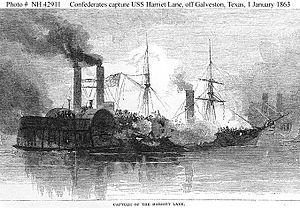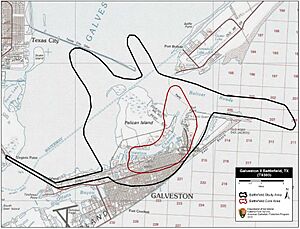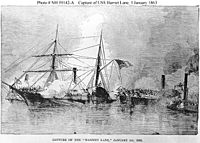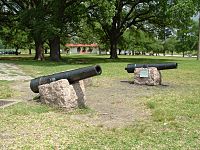Battle of Galveston facts for kids
Quick facts for kids Battle of Galveston |
|||||||
|---|---|---|---|---|---|---|---|
| Part of the Trans-Mississippi Theater of the American Civil War |
|||||||
 CS Bayou City captures USS Harriet Lane during the Battle of Galveston |
|||||||
|
|||||||
| Belligerents | |||||||
| Commanders and leaders | |||||||
| Units involved | |||||||
| West Gulf Blockading Squadron 42nd Massachusetts Infantry |
Department of Texas, New Mexico and Arizona Texas Marine Department |
||||||
| Strength | |||||||
| 6 gunboats unknown infantry |
2 gunboats unknown infantry |
||||||
| Casualties and losses | |||||||
| ca. 420 captured 1 gunboat captured 1 gunboat destroyed |
26 killed, 117 wounded | ||||||
The Battle of Galveston was an important fight during the American Civil War. It happened on January 1, 1863, in Galveston, Texas. In this battle, soldiers from the Confederate States took back the city of Galveston from Union troops.
This battle is sometimes called the Second Battle of Galveston. This is because another naval fight, the Battle of Galveston Harbor, happened in October 1862.
Contents
The Battle Begins
Confederate forces, led by Major General John B. Magruder, planned to attack the Union ships and soldiers in Galveston. They used two special boats called cottonclads. These were regular ships covered with cotton bales to protect them from enemy fire.
The two Confederate cottonclads were the CS Bayou City and the CS Neptune. They sailed from Houston to Galveston to fight the Union fleet. The Union fleet had six gunboats: USS Clifton, USS Harriet Lane, USS Westfield, USS Owasco, USS Corypheus, and USS Sachem.
The Confederate ships were outnumbered, but they fought bravely. The Neptune was badly damaged and sank. However, the Bayou City managed to capture the Union ship USS Harriet Lane.
Union Commander's Fate
During the fight, the Union ship USS Westfield got stuck on a sandbar. Confederate General Magruder offered a three-hour break in fighting to talk. But the Union Fleet Commander, William B. Renshaw, refused.
Instead, Renshaw tried to blow up the stuck Westfield. He wanted to stop it from falling into Confederate hands. Sadly, the explosives went off too early. Renshaw and several Union soldiers were killed in the explosion.
Union Surrender on Land
When the Union troops on shore saw the Westfield explode, they thought their ships were giving up. So, they put down their weapons and surrendered. The remaining Union ships did not surrender. They managed to escape and sailed away to New Orleans, which was controlled by the Union.
-
Replicas of the "Twin Sisters", which were used in the 1836 Battle of San Jacinto and the 1863 Battle of Galveston.
After the Battle
The Battle of Galveston was a big victory for the Confederates. The Union blockade around Galveston was lifted for four days. Galveston remained the only major port in Confederate hands until the end of the war.
The Confederate Congress praised the soldiers for their "bold, intrepid, and gallant conduct." They said the victory showed that "superior force may be overcome by skillful conception and daring courage." This meant that even though the Union had more ships, the Confederates won with smart planning and bravery.
See also
 In Spanish: Batalla de Galveston para niños
In Spanish: Batalla de Galveston para niños




